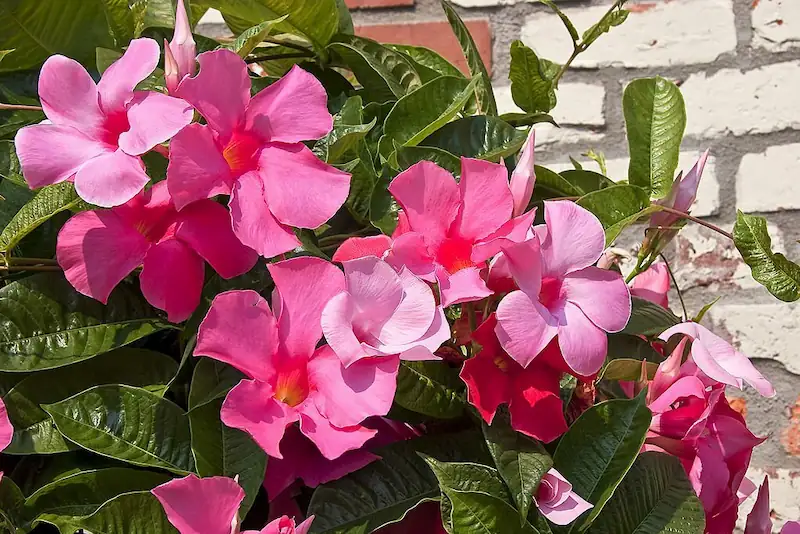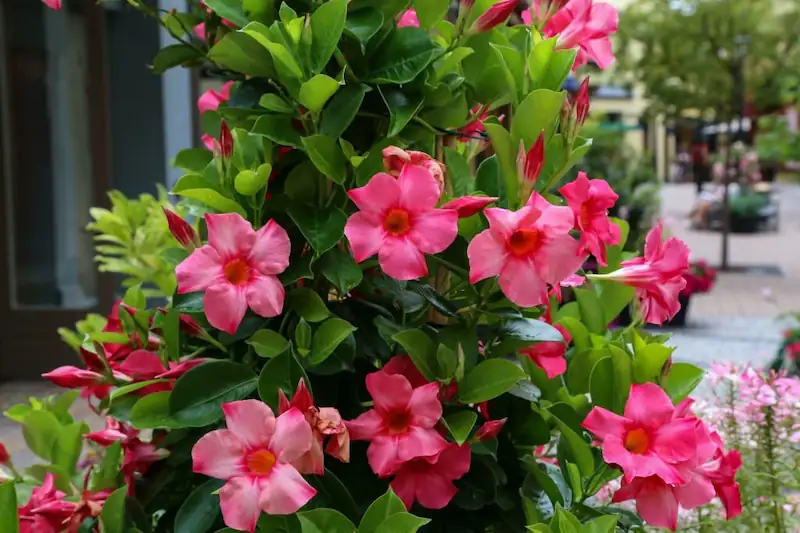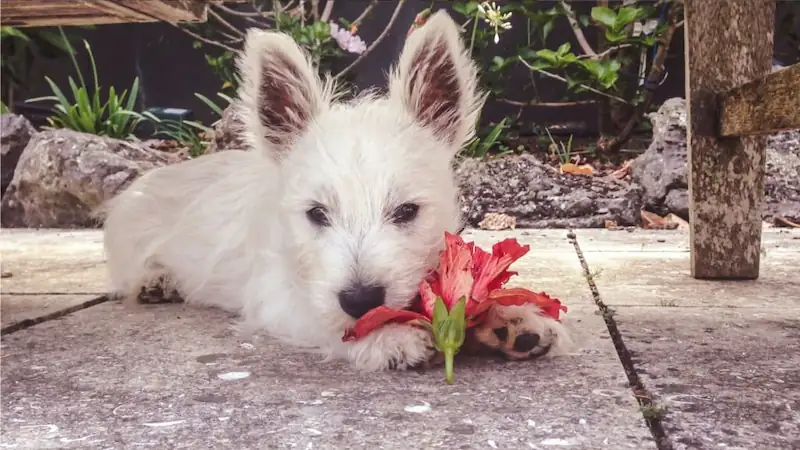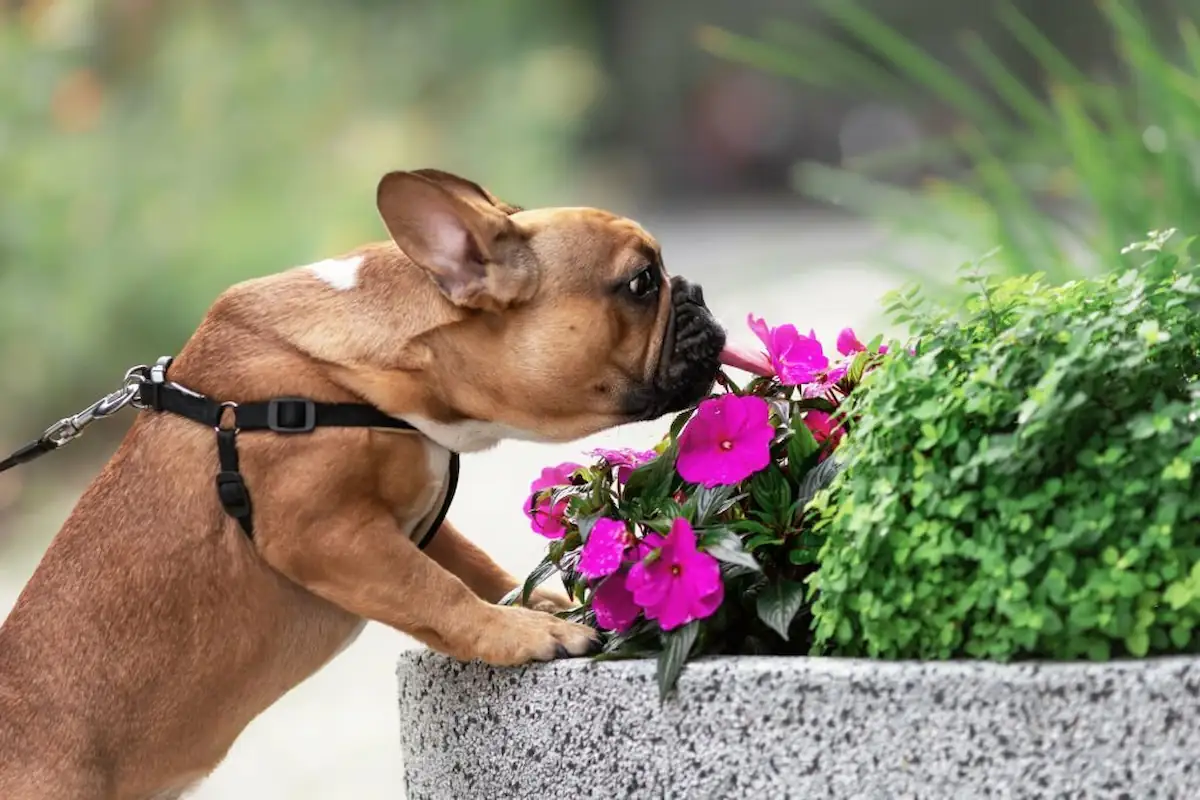The trumpet-shaped perennial is none other than the fragrant flower of Mandeville. Mandeville or Dipladenia is also known as Rock Trumpet because of its name.
As cute and colorful as it may sound, when it comes to the safety of your pets, you should pay attention to a plant’s toxicity.
Is Mandevilla or Dipladenia poisonous to Cats, Dogs, etc?

According to the official ASPCA, Mandevilla or Dipladenia are plants that are not considered poisonous or poisonous to dogs, cats, and other animals. However, if a pet ingests parts of the plant or its sap, they are susceptible to mild to severe indigestion.
As for the toxic content of the plant, if consumed, you can have various effects on pets. Let’s get to know them better for their furry friends.
Related: Potassium Bromide for Dogs: Uses, Dosage and Side Effects
To dogs:
Since dogs are curious little creatures, they are often attracted to the scent and color of Mandevilla or Dipladenia plants.
According to the ASPCA, neither Mandevilla nor Dipladenia fall into the category of plants poisonous to dogs.
However, like anything that is not edible, these plants can cause stomach problems for your dog if eaten in large quantities.
Few dogs, although not most, have fairly sensitive stomachs. If these dogs happen to lick the sap of the plant, you can expect your pet to suffer from vomiting and weakness.
About the cats:
Compared to dogs, cats have more sensitive stomachs and are much more prone to getting sick if they ingest something they shouldn’t.
If you doubt that your cat has eaten some of the milky juice that comes from Mandevilla or Dipladenia, they can say that your cat must be suffering from a digestive problem.
If the juice gets on the cat’s paws or lips, it may also suffer from skin irritation and allergies.
About other pets:
Like dogs and cats, Mandeville and Diplandia plants are mostly mildly poisonous to all animals such as rabbits, mice, and birds.
Gastronomic problems and stomach pain are the first effects that appear in animals when they ingest these two plants.
Although never fatal, Mandeville and Diplandia can make animals sick if they are reluctant to eat and exercise. In the worst case, however, tremors and cramps are also likely.
Related: What Fruits Can Dogs Eat? Which Fruit Is Not Safe for Your Dog?
Are Mandevilla or Dipladenia flowers poisonous to pets?

In animals with sensitive stomachs, certain parts of Mandevilla or Dipladenia plants can cause additional illnesses. For example, the flowering of plants can trigger vomiting in pets and in turn cause severe weakness.
When flowers contain chemically charged pesticides, pets that ingest large amounts of petals may even suffer from weakness and tremors.
Although not poisonous, Mandeville or Dipladenia flowers should be kept away from pets.
Are Mandevilla vines poisonous to pets?
The Mandevilla vine is particularly dangerous to pets because of the milky white sap it contains. When the vines are broken, sap flows from the parts.
Dogs, cats, and other pets are often attracted to taste the juice. Because it is unpleasant, it may discourage you from taking it in large quantities. In any case, lymph can cause allergic reactions and severely irritate a pet’s skin.
Related: Are Orbeez Water Beads Toxic to Dogs? (Important Facts!)
What are the toxic Parts of Mandevilla or Dipladenia?
In plants, some parts are more poisonous than others. If your pet eats the root instead of the stem, the problems the animal faces are different because the parts are not equally toxic.
Blooms:
The flowers are colorful and the parts that particularly attract animals as they find the scent and hues attractive.
Although these parts are not too toxic, pesticide chemicals deposited on flowers can cause indirect poisoning.
Depending on the amount of chemicals ingested by the animal and the number of leaves it has eaten, indigestion can range from mild to severe.
Chewing flowers and completely bloating them in large quantities can also cause an animal to vomit, as Mandeville or Dipladenia flowers are also not edible.
Stem and Roots:
From any split and broken part of the Mandevilla or Dipladenia plant, you will notice a milky white liquid oozing. This is the sap of the plant, which is more poisonous than the leaves and flowers of the same plant.
Since the juice doesn’t smell or taste as appetizing, your pet may not be as interested in eating the white substance. However, the sap could likely suffocate on the animal’s skin or even in the mouth area.
This can cause severe skin irritation, and visible redness and itching may occur almost immediately.
Leaves:
The problem with Mandevilla or Dipladenia leaves is the same as flowers and small flowers.
Because these leaves are usually covered in pesticides, ingesting or even chewing them can make animals sick. Juice may also come out of the leaves when chewing.
Related: Slideshow: What foods should dogs not eat? Get to know her now
What happens when pets consume Mandevilla or Dipladenia?

Although Mandeville or Dipladenia are not considered highly toxic to pets, the extremely low toxicity can still affect your pet. Here’s what you can expect if your pet ingests parts of the plant:
Indigestion:
However, Mandevilles are non-toxic and not edible. Because pets are attracted to colorful flowers, they may sometimes lick the sap from the steps or even bite and chew leaves and flowers.
One of the first signs of effects you may notice in your pet is stomach problems. From mild to severe digestive problems, the amount of Mandeville or Dipladenia the animal eats can also cause vomiting and nausea.
Skin Irritation:
In the Mandeville or Dipladenia plant, the sap causes most of the problems for the plants.
Because the sap comes from the plant stems and comes out of the leaves when chewed, if an animal comes into contact with the sap it can cause skin irritation.
This may include itching, redness, and swelling in the area. If you notice that your pet’s lip area becomes a little red and sore, you can assume that he has tried to taste the sap of the plant.
How to treat pets that consumed Mandevilla or Dipladenia?
If your pet has consumed Mandevilla or Dipladenia, here’s what you can do:
Treat:
They can cause vomiting in dogs and some other animals. Additionally, ask your vet to prescribe anti-inflammatory medication if the stomach condition is too severe. Sometimes you just rinse your mouth with a little water.
Wash:
Rinse and wash your pet completely. If necessary, they give him a nice bath to ensure that all the sap and leaves of the plants have been removed from the animal’s body.
Prevention:
Prevention is better than cure. Therefore, it is best to keep the plants completely away from pets.
If you want the plant and the pet, make sure to teach your pet commands that will discourage it from approaching such plants.
What is the difference between a Mandevilla and a Dipladenia?
Although they may be related, Mandevilla and Dipladenia have some notable differences. They are:
Growth:
Mandevilla and Dipladenia do not grow the same. While Mandeville grows in a pot and turns into a climbing plant, this does not apply to Dipladenia.
The latter can be grown in pots and does not necessarily require climbing. The two plants look significantly different when placed next to each other.
Leaves and Foliage:
There is a clear difference between Mandevilla and Dipladenia when it becomes a complete plant. Mandevilla foliage is long and narrow.
The leaves of Dipladenia, on the other hand, are heart-shaped. The leaves of Dipladenia are also wider than those of Mandevilla.
Flowers:
When it comes to the flowers, they may not be able to tell if there is a difference between the two plants.
However, Dipladenia has smaller flowers than Mandevilla flowers. The colors of the flowers produced by each plant also vary slightly.
Dipladenia flowers are usually yellow and pink, while Mandevilla flowers are mainly red and other shades of red. When it comes to telling the difference, flowers may not be so distinctive.
Final Thoughts
Mandevilla or Dipladenia plants are not listed in the category of poisonous plants that can harm dogs, cats, or other animals. However, in the dogbane family, certain parts can cause animals to become sick and have problems with indigestion. The sap of both plants can cause skin irritation in pets.
FAQs:
- Are there any safe alternatives to Mandevilla and Dipladenia for pet owners?
- Yes, there are many pet-friendly plants that can be safely grown indoors or outdoors. Some examples include African violets, spider plants, and Boston ferns.
- Can the toxins in Mandevilla and Dipladenia be fatal to pets?
- While rare, ingestion of large quantities of these plants can be fatal. It’s important to seek veterinary care immediately if poisoning is suspected.
- What should I do if my pet has ingested a toxic plant?
- Contact your veterinarian or an emergency veterinary clinic immediately. Do not attempt to induce vomiting or administer any home remedies without professional guidance.
- Are there any natural deterrents to keep pets away from toxic plants?
- Some pet owners use natural deterrents such as citrus peels or vinegar spray around plants to discourage pets from approaching them. However, these methods may not be effective for all pets.
- How can I identify Mandevilla and Dipladenia plants?
- Mandevilla and Dipladenia plants are known for their trumpet-shaped flowers and glossy, dark green leaves. They are often sold in garden centers and nurseries under their common names.

